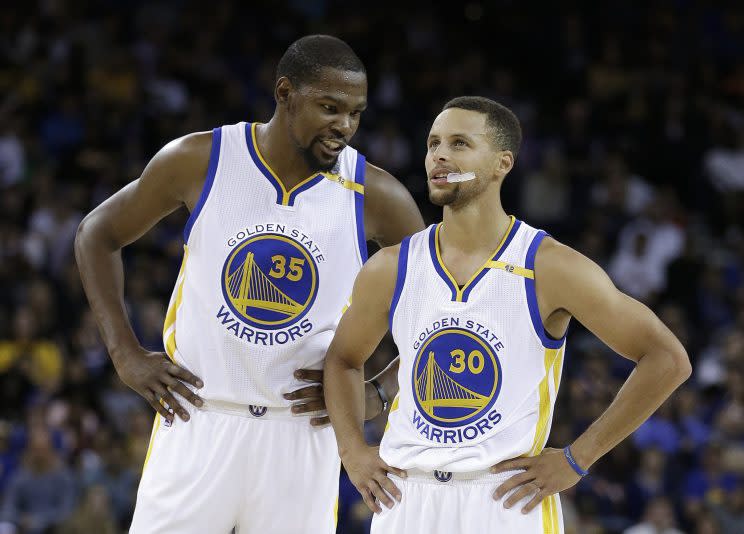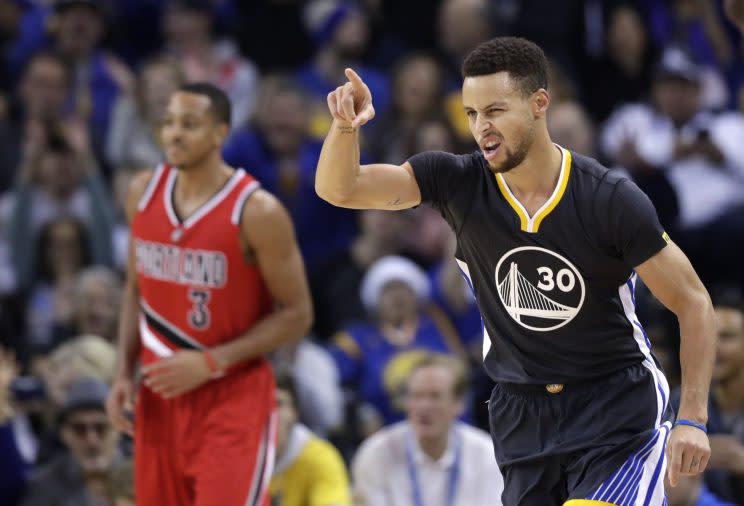How the Warriors can re-sign Kevin Durant and retain Steph Curry
The Vertical Front-Office Insider Bobby Marks, a former 20-year executive with the Nets, examines how the new CBA impacts the Golden State Warriors.
Golden State took advantage of the rise in the salary cap last summer to land Kevin Durant, but things wont be so easy next July.
Golden State has the best record in the league with the 14th-highest payroll that falls below $100 million, but it will face some difficult roster decisions in the future.
Similar to an expansion draft, when teams protect their own players from being selected, Golden State will face a similar fate starting in July.
The Vertical analyzes the Warriors cap’ situation next summer and looks at what the future might hold.
The summer of 2017
In a perfect world, Durant would opt into his $27.7 million salary at the end of June, which would help the pieces of the Warriors’ cap puzzle fall into place.
Durant signed a one-year contract with a player option on the second year with the intent of earning Tier 1 max status that comes with 10 years of service. Opting out would see his salary increase from $27.7 million to $36 million.
The new CBA reflects the actual percentage of a max salary player to the salary cap.
Before the change, Durant’s max salary slot was projected to be $33.8 million (32.8 percent of $103 million). With the change, Durant’s starting salary next summer will be $36 million with Golden State needing to carve out an additional $2.3 million in cap space to retain him.
Because Durant has non-Bird rights, he is restricted to signing a contract no more than 120 percent ($31.8 million) of his current salary for next season if not using cap space. Like last summer, the Warriors would need to create cap space to sign him to a Tier 1 max salary that starts at $36 million.
If Durant were to opt out, the Warriors would need to prioritize their current free agents, but that doesn’t mean Stephen Curry.
Because of Curry’s low cap hold ($18.1 million), Golden State can sign Durant with cap space and use Bird rights to exceed the salary cap to sign Curry to a salary starting at $36 million.
Though Curry is a Tier 2 max player (seven to nine years of service and 30 percent of the cap), the reigning MVP would fall into the new “veteran designated exception” category of the CBA.
Curry, who will have eight years of service in July, will be eligible to sign for 35 percent of the salary cap (Tier 1 max) because he would have met the All-NBA criterion.
The new rule incentivizes All-Star-level players to remain with their current teams.
The new pact would see Curry earn a contract valued at $209 million over the next five years. If Curry were to leave in free agency, the most a team could offer is four years, $132 million.
Salary-cap gymnastics
Last summer Golden State traded center Andrew Bogut and let go restricted free agents Harrison Barnes and Festus Ezeli to clear cap. That will likely occur again this summer at the possible cost of Andre Iguodala and Shaun Livingston.
Because Durant would need to be signed with cap space, the large cap holds of both Shaun Livingston ($10.9 million) and Andre Iguodala ($16.7 million) would need to be renounced.
Could both players take significant pay cuts to stay with Golden State?
Yes, but both veterans likely will be looking for their last big contracts.
Golden State will also lose $2.5 million in cap space because of the new rules.
The minimum contract for rookie Patrick McCaw will increase from $905,000 to $1.3 million. The free-agent holds of David West, Ian Clark, Anderson Varejao and JaVale McGee will increase from $1 million to $1.47 million.
Starting July 1, each minimum contract and free-agent minimum cap hold will adjust to reflect the new minimum salary scale.
In addition, the first-round rookie-scale contracts of Kevon Looney and Damian Jones will also be amended. Because both players’ salary for 2017-18 falls below the new minimum salary scale, their new salaries will now reflect the minimum for a player with one year of service (Jones) and two years of service (James).
A look at the Warriors’ cap situation heading into next summer and how Golden State can sign Durant:
A. Guaranteed Salary
Klay Thompson $17,826,150
Draymond Green $16,400,000
Damian Jones $1,312,611
Kevon Looney $1,471,382
Patrick McCaw $1,312,611
B. Free-agent cap hold
Kevin Durant $31,848,120
Stephen Curry $18,168,539
Andre Iguodala $16,697,052
Shaun Livingston $10,986,655
David West $1,471,382
Zaza Pachulia $3,477,600
Ian Clark $1,471,382
James Michael McAdoo $1,251,245
Anderson Varejao $1,471,382
JaVale McGee $1,471,382
C. Dead money
Jason Thompson $945,126
Salary table 2017
A. Guaranteed salaries $38,322,754
B. Free-agent cap holds $88,314,739
C. Dead money $945,126
Salaries: cap $127,582,619
Salary cap $103,000,000
Cap space None ($24,582,619 over)
Removing the cap holds of Iguodala, Livingston and Varejao would give the Warriors the cap space needed to sign Durant.
Creating cap space
With Durant signed to the max in this scenario and Curry’s cap hold still on the books, the attention now turns to the bench.
However, unlike last summer, when the Warriors were restricted to using the room mid-level ($2.9 million) to sign Zaza Pachulia and the minimum exception on David West, Golden State could have available cap space.
Golden State can renounce their remaining free agents except for Clark and have $4.7 million in room, plus the projected $4.3 million room mid-level to use for free agents.
Clark will have early Bird rights and Golden State can exceed the cap to sign him to the average player salary (roughly $7.4 million) once it reaches the cap.
The Warriors do not have a first-round pick to factor in for cap purposes. The pick was traded to Utah when the Warriors cleared cap space in 2013 to sign Iguodala.
The projected room factors in $3.2 million of incomplete roster charges.
Golden State will be charged $815,000 for every roster spot that falls below 12.
In this scenario the Warriors would be charged four roster spots.
The projected roster next year
How can a team that will use cap space to sign Durant next summer find themselves as a luxury-tax team?
The eventual Durant signing and what the Warriors do with the remaining cap space will push the Warriors right at the salary cap.
Once all the cap space is used, Golden State would then be allowed to sign Curry with Bird rights and exceed the salary cap.
Curry’s $18 million free-agent cap hold will now be replaced with a likely $36 million salary.
The remainder of the roster would be filled using the room mid-level exception and minimum players, meaning the total committed salaries for next season will likely be $135 million. Golden State will likely be in the luxury tax with a $21.5 million penalty.
A. Under contract
Kevin Durant $36,050,000
Stephen Curry $36,050,000
Klay Thompson $17,826,150
Draymond Green $16,400,000
Patrick McCaw $1,312,611
Damian Jones $1,312,611
Kevon Looney $1,471,382
FA: Ian Clark $7,400,000
FA: cap space $4,779,739
FA: room mid-level $4,328,250
Free-agent Minimum $1,471,382
Free-agent Minimum $1,471,382
Free-agent Minimum $1,471,382
Free-agent Minimum $1,471,382
Free-agent Minimum $1,471,382
B. Dead money
Jason Thompson $945,126
Salary table 2017
A. Guaranteed salaries $134,287,653
B. Dead money $945,126
Salaries: cap $135,232,779
Salaries: tax $135,232,779
Salary cap $103,000,000
Luxury tax $123,000,000
Cap space None ($32,232,779 over)
Tax room None ($12,232,779 over)
The future
The Warriors will pay a significant price to keep this team together.
With four players earning over $100 million, Golden State will likely be a tax team for the next three seasons.
The Big Four
Salary 2017-18 2018-19 2019-20 2020-21
Steph Curry $36.1M $38.9M $41.8M $44.7M
Kevin Durant $36.1M $37.8M $39.7M $41.5M
Klay Thompson $17.8M $19M FA (a)
Draymond Green $16.4M $17.5M $18.5M FA (b)
Total $106.4M $113.2M $100.0M $86.2M
(a)Thompson’s max contract in 2019-20 will be $32.4 million or $37.8 million
(b)Green’s max contract in 2020-21 will be $32.7 million or $38.1 million
Thompson and Green could eventually be Tier 1 max eligible in free agency if they meet the All-NBA criterion in the future. However, the new rule only allows two Tier 1 max players per team (if they were drafted or traded during their rookie contracts).
Because of future cap restrictions Golden State will need to put a heavy emphasis on player development with their current and future first-round picks, and continue to find under-the-radar talent such as McCaw, a second-round pick.
Although Golden State would not need to trade one of their four All-Stars, the Warriors will need to weigh roster flexibility and tax consequences against their ability to put a championship product on the court.
With all four players in the prime of their careers, Golden State can put a championship level product on the court for years to come, even if that comes with a tax penalty and the need for more cap creativity.
More NBA coverage from The Vertical:





